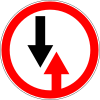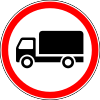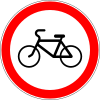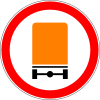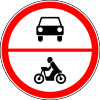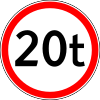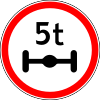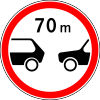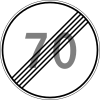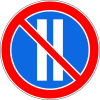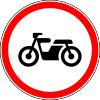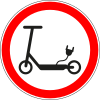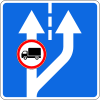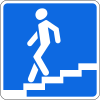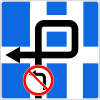
Road signs in Lithuania conform to the general pattern of those used in most other European countries as set out in the 1968 Vienna Convention on Road Signs and Signals.[1] Due to the country being occupied and annexed by the Soviet Union between 1940 and 1990, when it restored its independence, modern road signs used in Lithuania are in many ways similar in design to road signs used in the Soviet Union before its dissolution in 1991. This design of road signs is still used in most post-Soviet states, in particular Russia, Belarus, and Ukraine. Neighboring post-Soviet Baltic countries Latvia and Estonia, which were also occupied by the Soviet Union in 1940, have significantly modified their road sign designs, resulting road signs in these two countries being extremely different in design from road signs used in most other post-Soviet states.
Lithuanian road sign design saw minor changes in 2014. Some of the warning signs design were changed, a few new signs were added, like the sign indicating speed bump (formerly uneven road sign was used for indicating speed bumps), or sign indicating emergency stopping lane. Also, Lithuania is the only post-Soviet state to use both a blue and green background on the "Motorway" road sign. Lithuania formerly used only green background on the "Motorway" road sign, as now do the rest of the post-Soviet states.
The official typeface used on road signs in Lithuania is based on the Soviet standard GOST 10807-78 (Russian: ГОСТ 10807-78).[2]
YouTube Encyclopedic
-
1/5Views:3 2016 289930 03517 57784 507
-
LITHUANIAN LESSON 85 - EISMAS - Traffic/Driving
-
Driving in Lithuania 2022. 03.
-
Road Signs || Traffic Signs || Road Signs In English With Pictures || Road Symbols Vocabulary
-
Road signs traffic theory | www.traffictheory.nl
-
Large vehicles in roundabouts
Transcription
History
The first road signs arrived in Lithuania on 1 October 1930 after the President of the Republic Antanas Smetona signed the International Convention on automobile traffic.[3] In 1940, after the Soviet Union occupied and subsequently annexed Lithuania, the Soviet road traffic rules and road signs, which had been in force in the Soviet Union since 1936, were adopted in Lithuania.[4] On January 1, 1980, the standard GOST 10807-78 (Russian: ГОСТ 10807-78) was adopted in the Soviet Union, including the territory of present-day Lithuania. In 1990, after Lithuania restored its independence by the Act of the Re-Establishment of the State of Lithuania and the dissoltion of the Soviet Union in 1991, the Soviet road sign design used remained unchanged.[5]
Due to the fact that modern road signs in Lithuania are very similar in design to Soviet signs, including modern Russian, Belarusian, Ukrainian, and Moldovan signs, there have been proposals to change the design of road signs used in Lithuania. In 2020, Seimas deputy Kęstutis Masiulis addressed the Minister of Transportation Jaroslavas Narkevičius with a proposal to change the design of road signs, which had not been changed since Soviet times.[6] He stated the following about it:
Lietuvos kelio ženklų dizainas per 30 laisvos Lietuvos metų mažai keitėsi ir yra beveik toks pat, kaip buvo naudojamas Sovietų Sąjungoje, o dabar vis dar yra naudojamas Rusijoje, Baltarusijoje, Ukrainoje, Moldovoje ir kitur. Taip simboliškai vis dar esame buvusios SSRS įtakos zonoje. Lenkijoje, Vokietijoje, Prancūzijoje ir kitose Vakarų Europos šalyse kelio ženklinimo dizainas pastebimai skiriasi nuo lietuviško. Jeigu jau esame Vakarų pasaulio dalis, kodėl vis dar išlaikome net ir simbolines sąsajas su SSRS?
The design of Lithuanian road signs has changed little in the 30 years of free Lithuania, and is almost identical to that used in the Soviet Union and still used in Russia, Belarus, Ukraine, Moldova and elsewhere. Symbolically, we are still in the zone of influence of the former USSR. In Poland, Germany, France and other Western European countries, the design of road signs is markedly different from that in Lithuania. If we are already part of the Western world, why do we still retain even symbolic links with the USSR?
— Kęstutis Masiulis
In March 2022, after the Russian invasion of Ukraine started, two road signs were installed in the Liepkalnis area of Vilnius, indicating distances to the Ukrainian and Belarusian capitals, Kyiv and Minsk, respectively.[7] The Ukrainian flag is displayed at the bottom of the sign indicating the distance to Kyiv on the left, while "OCCUPIED BY KREMLIN" is written at the bottom of the sign indicating the distance to Minsk on the right.
On 2 April 2024, Seimas deputies Andrius Vyšniauskas, Paulė Kuzmickienė and Mindaugas Skritulskas appealed to the Minister of Transport, proposing to change the design of road signs, because in their opinion, the design of road signs used in Lithuania is similar to the signs used during the Soviet occupation. "Lithuania has not only identified itself with the Western world for more than 30 years, but is also a part of it. We do not associate our identity with the states stuck in the post-Soviet space, which were part of the USSR, even more so with Russia or Belarus. In the course of Russia's war against Ukraine and against the entire democratic Western world, we are trying to sever all links with the criminal authoritarian regimes of Russia and Belarus. However, after crossing the Lithuanian-Russian or Lithuanian-Belarusian borders, we are greeted by the same or very similar Soviet standard road signs with the same Soviet font. We are able to remove Soviet boulders from city squares, move soldiers' cemeteries, it is time to abandon these Soviet relics as well", says Seimas member A. Vyšniauskas.[8] However, the Ministry of Transport and Communications states that there is no sufficient legal basis to change the design of road signs following the example of other countries. The ministry also emphasized that installing one standard road sign costs an average of 200 euros.[9][10][11]
Warning signs
- 1. Warning signs
-
Level crossing ahead, with gates
-
Level crossing ahead, without gates
-
Roadworks
-
Swing bridge
-
Unprotected quayside or riverbank
-
Children
-
Crossroads without priority (give way to the vehicles coming from the right)
-
Junction with minor road
-
Junction with minor road (from the right)
-
Junction with minor road (from the left)
-
Roundabout
-
Traffic signals
-
Dangerous curve to the right
-
Dangerous curve to the left
-
Double curve, first to the right
-
Double curve, first to the left
-
Steep descent
-
Steep ascent
-
Slippery road
-
Uneven road
-
Gravel loose
-
Dangerous shoulder
-
Road narrow on both sides
-
Road narrow on right side
-
Road narrow on left side
-
End of one-way traffic
-
Pedestrian crossing
-
Pedestrians
-
Cyclists
-
Cattle crossing
-
Deer crossing
-
Falling rocks
-
Crosswinds
-
Low-flying aircraft
-
Traffic jams
-
Accidents area
-
Other dangers
-
Level crossing (single track)
-
Level crossing (multiple tracks)
-
Level crossing countdown
-
Level crossing countdown
-
Level crossing countdown
-
Level crossing countdown
-
Level crossing countdown
-
Level crossing countdown
-
Chevron right
-
Chevron left
-
Curve to the (T)
-
Ruts ahead
-
Speedbump
Priority signs
- 2. Priority signs
-
Priority road
-
End of priority road
-
Give way
-
Stop
-
Give priority to oncoming traffic
-
Priority over oncoming traffic
Prohibitory signs
- 3. Prohibitory signs
-
Do not enter
-
Closed to all vehicles in both directions
-
No motor vehicles except motorcycles
-
No trucks
-
No entry for motorcycles
-
No tractors
-
No trailers
-
No animal-drawn vehicles
-
No cycles
-
No pedestrians
-
No vehicles carrying dangerous goods
-
No power-driven vehicles
-
No power-driven or animal-drawn vehicles
-
Mass limit
-
Total mass limit
-
Height limit
-
Width limit
-
Length limit
-
Minimum separation
-
Passing without stopping prohibited
-
Passing without stopping prohibited
-
Passing without controlling prohibited
-
No right turn
-
No left turn
-
No U-turn
-
No overtaking
-
End of overtaking prohibition
-
No overtaking by trucks
-
End of overtaking prohibition by trucks
-
70 km/h maximum speed limit
-
End of 70 km/h speed limit
-
No audible warning devices
-
No stopping
-
No parking
-
Alternate parking on odd days
-
Alternate parking on even days
-
End of all prohibitions
-
No mopeds
-
No vehicles carrying explosive or readily inflammable substances
-
No vehicles carrying substance liable to cause water pollution
-
No motorized scooters
-
No residential vehicles
Mandatory signs
- 4. Mandatory signs
-
Proceed straight
-
Turn right
-
Turn left
-
Straight ahead or right turn permitted
-
Straight ahead or left turn permitted
-
Keep right
-
Keep left
-
Keep left or right
-
Roundabout
-
Cycle path
-
Pedestrian path
-
Cycle and pedestrian path
-
Cycle and pedestrian path
-
Minimum speed
-
End of minimum speed
-
Proceed straight for vehicles carrying dangerous goods
Regulatory signs
- 5. Regulatory signs
-
Dual motorway
-
End of dual motorway
-
One-way street
-
Two-way lanes
-
One-way street to the right
-
One-way street to the left
-
Traffic directions at the intersection
-
The direction of traffic at the intersection is straight
-
The direction of traffic at the intersection is to the right
-
The direction of traffic at the intersection is left
-
The direction of traffic at the intersection is straight and right
-
Added lane from right
-
Added lane from left
-
End of the right lane
-
End of the left lane
-
Traffic directions in traffic lanes
-
Traffic directions in traffic lanes
-
Traffic directions in traffic lanes
-
Lane start and limits
-
Traffic in lanes
-
Added lane from junction
-
Added lane from junction
-
Lane reserved for buses
-
Lane reserved for buses
-
Entrance to the road with a lane for buses
-
Entrance to the road with a lane for buses
-
U-turn
-
Parking
-
Parking on limited duration only
-
Parking on time period only
-
Reserved parking only
-
Parking of bus vehicle
-
Pedestrian crossing
-
Pedestrian crossing
-
Underground pedestrian crossing
-
Footbridge
-
Advisory speed
-
No parking zone
-
Parking zone
-
Speed limit zone
-
End of no parking zone
-
End of parking zone
-
End of speed limit zone
-
Start of tunnel
-
End of tunnel
-
Bus stop
-
Taxi stop
-
Start of city limit
-
Start of city limit
-
Start of city limit
-
End of city limit
-
End of city limit
-
Residential area
-
End of city limit
-
End of residential area
-
Stop-line
-
Motorway
-
End of motorway
-
Safety island
-
Emergency stopping lane
-
Bicycle street
-
End of bicycle street
Information signs
- 6. Information signs
-
Advance direction indicator
-
Advance direction indicator
-
Advance direction indicator
-
Advance direction indicator
-
Advance direction indicator
-
Advance direction indicator
-
Indication of direction
-
Indication of direction
-
Indication of direction
-
Indication of direction
-
Driving scheme
-
Driving direction for trucks
-
Dead end
-
Start of city
-
End of city
-
River name
-
County name
-
Street name
-
Street name
-
Distance index
-
General speed limits
-
Kilometer sign
-
Kilometer sign
-
International Road number
-
County Road number
-
Motorway number
-
Number and direction of the road
-
Number and direction of the road
-
Number and direction of the road
-
Number and direction of the road or cycle track
-
Number and direction of cycle track
-
Circuit diagram
-
Detour direction
-
Detour direction
-
Reordering arrow
-
Directional arrow to point of interest
-
Name of the place to visit
-
Direction pointer to national, regional parks, state nature reserves, state nature and complex reserves
-
Beginning of a national, regional park, state nature reserve, state natural or complex reserve
-
End of national, regional park, state nature reserve, state natural or complex reserve
-
Direction to historical national, historical regional parks, state cultural reserves, museums
-
Name of historical national, historical regional park, state cultural reserve, museum
-
Republic of Lithuania EU sign
-
Automatic traffic control
-
Automatic traffic control
Service signs
- 7. Service signs
-
First aid post
-
Hospital
-
Filling station
-
Breakdown service
-
Car washing
-
Public telephone
-
Restaurant
-
Refreshment
-
Hotel
-
Camping site
-
Caravan site
-
Caravan and camping site
-
Picnic site
-
Police station
-
Public lavatory
-
Swimming pool
-
Drinking water
-
Customs area
-
Airport
-
Information zone
-
Youth hostel
-
Rural tourism homestead
-
National historic/cultural/tourist site
-
Fishing
-
Golf sport
-
Equestrian sport
-
Ski lift
-
Bus station
-
Train station
-
Vehicle ferry
-
Registry of vehicles or drivers
-
Technical inspection station
-
Electric car charging place
-
Industrial zone
Additional panels
- 8. Additional panels
-
Distance
-
Side extension (of no stopping or no parking)
-
Side extension (of no stopping or no parking)
-
Stop ahead
-
Length
-
Beginning (of no stopping or no parking)
-
Continuation (of no stopping or no parking)
-
Ending (of no stopping or no parking)
-
Validity area to the right
-
Validity area to the left
-
Validity area in both directions
-
Direction of validity to the right
-
Direction of validity to the left
-
Direction of validity in both directions
-
Type of vehicle: Trucks
-
Type of vehicle: Vehicles with trailers
-
Type of vehicle: Cars
-
Type of vehicle: Buses
-
Type of vehicles: Tractors
-
Type of vehicles: Motorcycles
-
Type of vehicles: Cycles
-
Saturdays, sundays and holidays
-
Working days
-
Days of the week
-
Day of the week
-
Time period
-
Time period during saturdays, sundays and holidays
-
Time period during working days
-
Time period during days of the week
-
Parking method of vehicle
-
Parking method of vehicle
-
Parking method of vehicle
-
Parking method of vehicle
-
Parking method of vehicle
-
Parking method of vehicle
-
Parking method of vehicle
-
Parking method of vehicle
-
Parking method of vehicle
-
Parking of no working engine only
-
Payment services
-
Payment services during saturdays, sundays and holidays, working days, days of the week and time period
-
Dangerous roadside
-
Direction of priority road
-
Direction of priority road
-
Blind pedestrians
-
Wet coating
-
Disabled parking
-
Except for the disabled
-
Ice or snow
-
Compressed natural gas
-
Compressed natural gas
-
Liquified petroleum gas
-
Liquified petroleum gas
-
Types of fuel
-
Type of vehicle: Mopeds
-
Except for cycles
-
Type of vehicle: Electric cars
-
Except for electric cars
-
Bicycle traffic
-
Type of vehicle: Residential vehicles
References
- ^ Kelių eismo taisyklių 1 priedas – www.ketbilietai.lt
- ^ "Seimo nariai siūlo keisti kelio ženklų dizainą: ragina atsisakyti sovietinio standarto". Delfi auto (in Lithuanian). Retrieved 7 April 2024.
- ^ Žičkus, Ričardas. "Įdomioji istorija: pirmieji kelio ženklai Lietuvoje, kai dar nereikėjo žalių rodyklių". 15min.lt/verslas (in Lithuanian). Retrieved 3 November 2023.
- ^ "Pirmieji kelio ženklai Lietuvoje: kada atsirado ir kokie buvo?". www.lrytas.lt. Retrieved 7 April 2024.
- ^ "Konservatorius nerimsta: vėl kreipėsi į susisiekimo ministrą dėl "sovietinių kelio ženklų keitimo"". infa.lt (in Lithuanian). 16 May 2022. Retrieved 3 November 2023.
- ^ "Konservatoriui nepatinka sovietinio dizaino kelio ženklai". Kauno diena (in Lithuanian). 21 January 2020. Retrieved 9 January 2024.
- ^ "Vilnius mayor expresses support for Ukraine with road signs". lrt.lt. 10 March 2022. Retrieved 7 April 2024.
- ^ Vilnius, Made in (2 April 2024). "Suggests changing the design of road signs". MadeinVilnius.lt - Vilniaus naujienų dienoraštis. Retrieved 7 April 2024.
- ^ "Iš jūsų – po 200 eurų už naują kelio ženklą: konservatorių siūlymą lenkia net ministerija". tv3.lt (in Lithuanian). Retrieved 7 April 2024.
- ^ "Dabartiniai kelio ženklai – sovietinis palikimas? Vien valstybiniuose keliuose jų ketvirtis milijono". lrt.lt (in Lithuanian). 3 April 2024. Retrieved 7 April 2024.
- ^ "Planuojami pokyčiai dėl kelio ženklų – pirmieji žingsniai numatomi rudenį". Delfi auto (in Lithuanian). Retrieved 7 April 2024.




















































